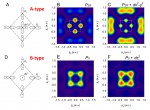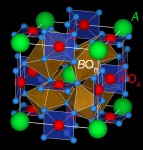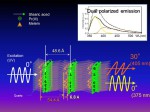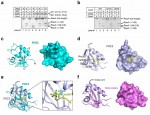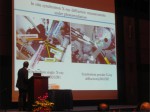Volume 16, No.3
August issue 2011
1. 最近の研究から/FROM LATEST RESEARCH
(財)高輝度光科学研究センター 利用研究促進部門 Research & Utilization Division, JASRI
- Abstract
- 銅酸化物高温超伝導体La2-xSrxCuO4は、Sr置換量を増やすにつれて、反強磁性絶縁体相から金属相に至るまで多様な性質を持つ相を示す。Sr原子の化学結合に寄与する価電子数はLa原子より1個少ないので、Sr置換はホール(電子を取り去った後にできる孔)を超伝導体にドープする。ホール・ドープ量によってホール状態がどのように変化するかを明らかにするためにコンプトン散乱実験を行い、ホール状態を運動量密度分布として可視化することに成功した。この結果は、最高の超伝導転移温度を示す最適ドープまでのアンダー・ドープ領域においてホールはO 2p軌道に入るが、最適ドープを越えたオーバー・ドープ領域においてはCu 3d軌道に入ることを示している。本研究は、コンプトン散乱によってホール状態のイメージングに成功した最初の例である。
愛媛大学大学院 理工学研究科 Graduate School of Science and Engineering, Ehime University
- Abstract
- 15万気圧・1000℃の超高圧高温条件で合成された新物質SrCu3Fe4O12は、線膨張係数α = −2.26 × 10-5 K-1という大きな負の熱膨張を示した。放射光粉末X線回折に基づく結晶構造解析により、SrCu3Fe4O12の負の熱膨張は、サイト間電荷移動によるオーバーボンディングの解消という、新しいメカニズムによっておこることが示唆された。Ca2+ → Sr2+という等価数イオンによる置換で全く異なる性質が表れていることから、この物質系では様々な電子・結合状態が競合しており、類縁物質において新奇な物性が誘起される可能性があることを示している。
青山学院大学 理工学部 College of Science and Engineering, Aoyama Gakuin University
- Abstract
- 希土類錯体は、EuなどのランタニドにPI系の有機配位子が結合することで、本来禁制であるランタニドからのff遷移に伴う発光スペクトルを増強させることができる。私どもは、プラセオジム錯体の発光スペクトルを用い、分子内の光励起エネルギー移動の経路から高効率な発光を促す条件を知ることができた。この知見を基に、分子自身を有機合成化学により分子自身のドナー準位を調整し、発光スペクトルの選択性を証明した。さらに、単分子累積膜や高分子膜表面への吸着を利用し、結晶とは異なる分子配列を有する集合体が偏光発光を促す新しい系の創成とその構造の役割を証明した。
Center for Structural Biology, School of Medicine and School of Life Sciences, Tsinghua University
- Abstract
- Regulated Intramembrane Proteolysis (RIP) is a highly conserved signaling mechanism, where a signaling molecule is cleaved within the lipid bilayer by an intramembrane protease. Traditional wisdom argued that proteolysis requires water; however, in RIP, both the protease and the substrate are integral membrane proteins and the cleavage occurs within the hydrophobic lipid bilayer. It has been most intriguing to scientists how water molecules and substrate get access to the active site of an intramembrane protease. Based on the function and predicted active site, the characterized intramembrane proteases are classified into 4 families: the metalloprotease site-2 protease (S2P), the serine protease Rhomboid, the aspartyl proteases Signal Peptide Peptidase (SPP) and Presenilin. Intramembrane proteases play important roles in a wide range of cellular functions. For example, S2P is a key player in sterol metabolism in cells; Rhomboid works in the Wnt signaling pathway; Presenilin is the most notorious intramembrane protease as it directly cleaves Amyloid Precursor Protein (APP) and results in the accumulation of β-amyloid peptide, the direct pathogen for Alzheimer’s disease. In order to understand the working mechanism of RIP, it requires high-resolution structures of the intramembrane proteases both in the apo-form and in the substrate or inhibitor-bound forms. Successful determination of the proposed structures will also provide invaluable therapeutic potentials to fight deleterious diseases, such as Alzheimer’s disease and cardiovascular diseases. There were a number of important questions that we would like to address. In particular, we would like to understand what regulates the substrate access to the active site of the intramembrane proteases; what are the structure and function mechanism of SPP; and what are the structure and function mechanism of Presenilin? The proposed research aimed to address the above questions.
2. ビームライン/BEAMLINES
[1](財)高輝度光科学研究センター 利用研究促進部門 Research & Utilization Division, JASRI、[2](財)高輝度光科学研究センター 光源・光学系部門 Light Source and Optics Division, JASRI、[3](財)高輝度光科学研究センター 制御・情報部門 Controls and Computing Division, JASRI、 [4](独)理化学研究所 播磨研究所 放射光科学総合研究センター RIKEN SPring-8 Center
- Abstract
-
「グリーン・ナノ放射光分析評価拠点の整備」が、2010年度にBL37XU分光分析およびBL39XU磁性材料ビームラインにおいて行われた。本整備計画によって、これらのビームラインで100 nm オーダーの集光X線ビームを利用した蛍光X線分析、X線吸収分光(XAFS)およびX線磁気円二色性分光(XMCD)測定が可能となった。ナノスケールX線分析手法を提供することで、低炭素社会の実現に資するグリーン・ナノテクノロジー研究開発の促進と支援を目的としている。本稿では、本整備計画の目的、新設ステーションの概要、技術的な開発要素、可能となる利用研究について紹介する。
3. 研究会等報告/WORKSHOP AND COMMITTEE REPORT
[1](財)高輝度光科学研究センター 加速器部門 Accelerators Division, JASRI、[2](財)高輝度光科学研究センター 制御・情報部門 Controls and Computing Division, JASRI、[3](財)高輝度光科学研究センター 加速器部門 Accelerators Division, JASRI
(財)高輝度光科学研究センター 利用研究促進部門 Research & Utilization Division, JASRI
(財)高輝度光科学研究センター 利用研究促進部門 Research & Utilization Division, JASRI




